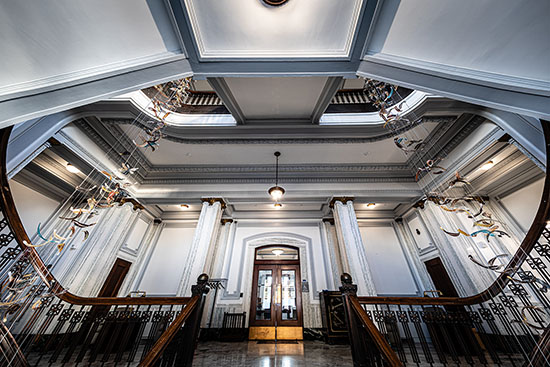|
Subscribe / Renew |
|
|
Contact Us |
|
| ► Subscribe to our Free Weekly Newsletter | |
| home | Welcome, sign in or click here to subscribe. | login |
Construction
| |
 |
May 5, 2023
RESTORATION OREGON

Oregon Supreme Court Building
Location: Salem
Contractor: The Harver Co.
Architect: Hennebery Eddy Architects
Team: International Union of Painters and Allied Trades; Northwest Carpenters Union; Operative Plasterers’ and Cement Masons’ International Association; CWallA; GTS Interior Supply; Salmon Bay Sand & Gravel; Western Materials; Dryvit Systems; Hilti; Scafco Steel Stud Co.; Trim-Tex; USG Building Systems
The Oregon Supreme Court stands as the oldest building in the Capitol Mall and houses, along with Oregon’s highest court, the Oregon Court of Appeals, the State of Oregon Law Library, and a repository of historical documents dating back to the 15th century. Originally built between 1911 and 1914, the three-story building showcases ornate cornices and rosettes, Ionic columns, majestic capitals, massive corbels, plaster coving in the Beaux-Arts style, egg and dart molds, grape friezes, Greek keys, a gorgeous spiral staircase, and plenty of curved walls and other architectural features that created challenges for workers plastering high and low.
The Harver Co. was awarded this project in March 2021, and it required constant adapting to the ever-changing COVID-19 safety protocols and managing supply chain shortages. The Harver team recreated plaster shapes made over 100 years ago over the course of eight months, pouring plaster and running molds on tables and sleds custom-built for the project.
The team ran molds on curved walls and maneuvered around staircases and columns, installed over 10,000 square feet of lath, bent over 500 pieces of cold roll and used over 44,000 pounds of plaster.
From extensive lath work, careful material handling, pouring urethane molds and running molds to installing each ornate piece, Harver brought quality and efficiency to the project.
The Oregon Supreme Court project represents the way in which the talent and skills of historic restoration can leave a lasting impact for generations to come, while bringing trades together to model leadership, communication and artistry. The project was also an opportunity for older plasterers to pass on the craft to younger plasterers. The entire project was an example of Harver’s triad of safety, quality and service.
Other Stories:
- INTERIOR UNDER $1 MILLION WASHINGTON
- LIGHT-GAUGE STEEL FRAMING UNDER $1M OREGON
- SUSPENDED CEILING OREGON
- EXTERIOR COMMERCIAL OREGON
- INTERIOR OVER $1 MILLION OREGON
- INTERIOR UNDER $1 MILLION OREGON
- STUCCO/EIFS WASHINGTON
- RESTORATION WASHINGTON
- RENOVATION WASHINGTON
- LIGHT-GAUGE STEEL FRAMING OVER $1 MILLION WASHINGTON
- SUSPENDED CEILING WASHINGTON
- EXTERIOR COMMERCIAL WASHINGTON
- EXTERIOR RESIDENTIAL WASHINGTON
- INTERIOR OVER $1 MILLION WASHINGTON
- LIGHT-GAUGE STEEL FRAMING OVER $1 MILLION OREGON


